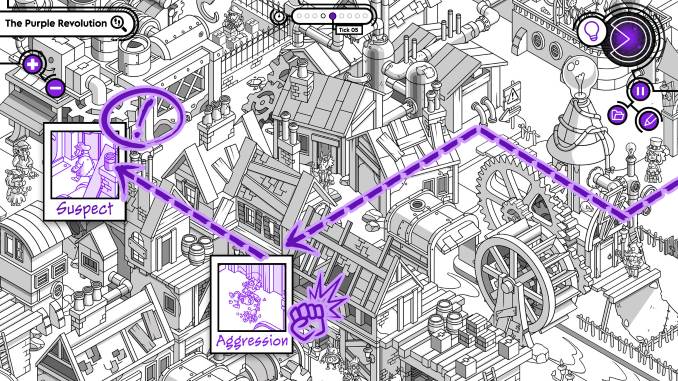As a kid, I really loved solving Where’s Waldo puzzles. I was never terribly good at them, but I enjoyed the handful that I could handle. Unfortunately for me, I never had the chance to get any better at these kinds of puzzles; call it laziness or elusiveness, but they mostly faded from my life after childhood until Crime O’Clock appeared on my radar some time ago. However, Crime O’Clock goes the extra step, bending the intention behind your otherwise fun search into something else that doesn’t sully the experience, but ever so slightly muddies the waters.
In Crime O’Clock, you’re an unnamed agent assisting an AI who is more or less policing the timeline. Nexus events and anomalies begin sprouting up and it becomes your job as partners to go into these instances, identify who or what is wrong about them, and course-correct as best as you can. Along the journey, it’s revealed that other “rogue” AIs are responsible for these events, and you slowly battle them across the ages. While that sounds more epic in nature, the reality of the situation is that you’ll mostly be staring at ever-shifting environments, tracking characters movements, and solving timed puzzles that represent your AI companions various functions, from identifying figures and their place in the timeline to pulling samples from fruit to see whether or not its poisoned.
Crime O’Clock is denser than it may let on, which proves to be a fun surprise as you push on into its various ages. Beginning in the Information Age (c. 2015 in Milan, where the developer is based), you eventually move backwards and forwards in time to the Steam Age and the far future. However, time-traveling through the ages isn’t the only way Crime O’Clock plays with time: every map consists of 10 “ticks” that your AI will dart between, meaning that the environments shift over time and the characters in them do too. Puzzles will usually begin on the final tick, showing you an unsightly outcome that breaks from the “true timeline,” before you essentially rewind, unravel the mystery and then prevent the crime. Each of these environments is thick with layers upon layers of illustrations meant to confound and delight in equal measure, making for fun, if devious, puzzles. (Small note: I played the game on PC and feel I greatly benefitted, even when I was struggling most, from a screen that could afford to show me lots of the map without stressing my eyes. Though I haven’t played it on the Nintendo Switch, which it’s also releasing for, I can’t imagine the smaller screen will help too much in this regard.) To lighten things, the maps are riddled with pop culture references befitting the times; across the several ages, I found references to Rick and Morty, Aladdin, Prince of Persia, The Mummy, Teenage Mutant Ninja Turtles, Neon Genesis Evangelion, and one mission that quite blatantly riffs on the plots of the two Blade Runner films.

That’s all irreverent fun. I enjoyed frantically scanning the screen for the suspects and eventually spotting anomalies. And the tools the game provides for your search add much-needed dimensions as the surprisingly long game begins to drag in service of an overarching narrative that just never quite clicked for me. These tools involve a “reality manipulator” which erases certain elements, revealing things they might be concealing and the CFE analyzer, an especially handy aid that lets you ping elements in the world and get a hot or cold rating based on their proximity to what you’re looking for. One even reconstructs the supposed insides of buildings, adding an additional, if somewhat small, layer to your searches. On almost every other turn, your AI companion will run a subroutine that delivers a mini-game meant to break up the exhaustive investigation; one has you matching hidden symbols, another has you making similar frequency waves, while yet another will task you with guiding lasers onto a circular grid of sorts. The game is certainly more varied than you’d expect, but the experience is all kind of soured by a lot of the…well, the underlying cop-yness of it all.
It should come as little surprise that a game with “crime” in the title has a cop bent to it, but I kind of found myself increasingly thrown at the solutions of so many of Crime O’Clock’s cases. In one early mission, you just kind of resolve to arrest a guy who’s being manipulated by forces greater than him because you can’t come up with a better solution to the anomaly he created. A good stretch of the middle consists of going back to an age that is supposedly pure of sins, and because of the rogue AIs introducing feelings such as wrath or envy to motivate crimes, you literally codify them into law—criminalizing feelings—in order to bust someone. Not just that, but the AI mini-games often obscure the fact that you’re hacking and profiling, and the very nature of the basic loop of the game is tailing suspects. Crime O’Clock‘s aware of this, sometimes seemingly poking fun at the shortcomings of policing that results in outcomes like these. The story even takes a turn in its last act to appear to face this notion, but the narrative doing a 180 can’t quite resolve the tension present in the several hours of reveling in being a time cop that lead up to this point. It can’t undo the enjoyment meant to be gained from the presence of mechanics and scenarios that reinforce the notion of being a cop of any sort. It’s just kind of toothless in this department.
Maybe this is a thing you can ignore as you work through Crime O’Clock‘s several cases, which if I’m being honest kept coming at an increasingly tiring rate, but I couldn’t. Rather than outright spoil the mood, it just lightly dirtied my enjoyment of an otherwise charming game. The mysteries themselves are varied enough to keep one coming back and see it through to the end, even if the dizzying narrative pulling it all together is a bit much. If you’re looking for a puzzle game with some longevity to sink your teeth into and want to recapture those youthful days of looking for Waldo though, Crime O’Clock’s a pretty good time though and an easy investment.
Crime O’Clock is developed by Bad Seed and published by Just For Games. Our review is based on the PC version. It is also available on Nintendo Switch.
Moises Taveras is the assistant games editor for Paste Magazine. He was that one kid who was really excited about Google+ and is still sad about how that turned out.

